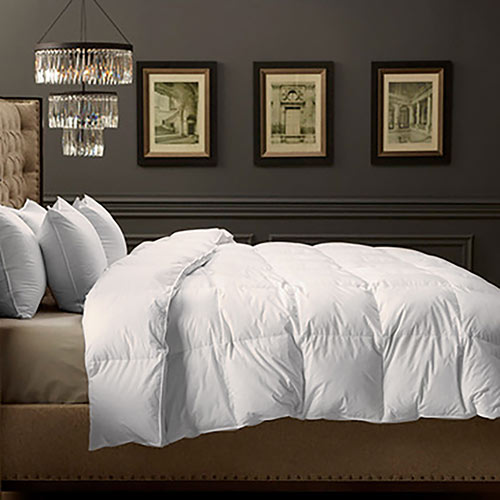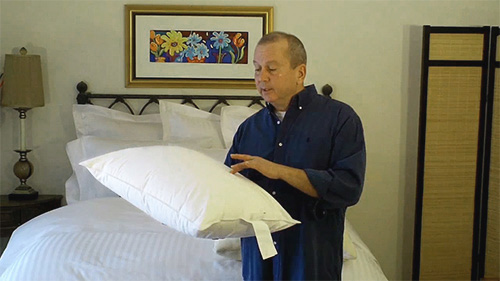What is a Baffle Box Down Comforter?
Baffle Box Down Comforters
Updated 1/2020
A baffle box down comforter is considered to be the best premium style of comforter. Many also refer to a down comforter as a duvet, not to be confused with a duvet cover, which is used to cover the duvet or comforter.
In the video below, we explain the benefits of this style of comforter and the drawbacks of other styles of comforters.

The baffle box down comforter shell is comprised of multiple compartments in which the down is contained. Unlike other construction styles, each chamber has a sidewall, as shown in the image below.

What these sidewalls do is give the individual compartments a 3-dimensional box type configuration. This box allows the down to loft more fully. Much like insulation in your house, lofted down traps more air, which holds in body heat.
Down does not generate heat, it only holds in the heat generated by the person under it.
Down comforters are likely the most popular top of the bed cover.
People enjoy sleeping under them as they are very light in weight and are not constricting as some other types of bed covers.
Down Comforters should be cleaned occasionally to keep them fresh.
Other styles of down comforters have limitations such as cold spots and construction styles that allow the down to shift or move around inside the comforter shell.
Down Comforters should be cleaned occasionally to keep them fresh.
- Most comforter manufacturers recommend dry cleaning them; some manufacturers recommend laundering them.
The video below explains how to launder your down comforter.
What is a Box Stitched Down Comforter?
What is a Box Stitched Down Comforter
Different construction styles of Down Comforters…

Box Stitched Down Comforter construction is produced by taking (2) large sheets of fabric (sewn around the outside perimeter) then the compartment is filled with Down.
- Once filled, this compartment is then sewn/quilted in a defined pattern (generally a square). This construction keeps the Down from shifting, which provides even warmth.
- Although this construction is preferred over those that don’t have sewn containment chambers, sewn through Box Stitch Comforters do not allow the Down to loft to its fullest capability and are generally a lower cost product than a Baffle Box style of Comforters.
- The better construction style is the Baffle Box.
What is Double Stitching on a Pillow or Down Comforter?
What is Double Stitching on a Pillow or Down Comforter
The best constructions for a down comforter or pillow.

Double Stitching and cording is found on the outer edges of better Sleeping Pillows and Down Comforters. This configuration represents a sign of quality and superior construction.
- The seams are stronger than single needle stitching and prevents the Down or Feather from escaping the compartment and the Piping or Cording as the Double Stitching adds durability to the edge of the pillow or comforter, which is usually the high wear area.
What are the different sizes of Mattresses available?
Mattress sizes
Standard US Mattress sizes…
For those of you who may be at work and do not want your co-workers to see or hear that video, here is a written version explaining the nuances of different mattress sizes.
It is not uncommon to have some confusion about various mattress sizes. More specifically, the differences between a full and queen size mattress or the differences between a California King and a King.
Whether you are looking to buy new bed linens or a new mattress, it is important to be certain of which mattress size is going to meet your needs. Here are some helpful hints about those varieties.
Twin – This is also referred to as a single and there are (2) varieties of this mattress: a regular Twin (39”x 75”) and an Extra Long Twin (39”x 80”).
- The majority of twin mattresses you will find in retail stores measure 39” x 75”. However, you could come across an extra-long Twin.
- It is important to know what kind of twin you are looking to buy. There are challenges when it comes to finding fitted sheets and, perhaps even flat sheets, for an extra-long twin. Not all sheets will fit properly.
- Extra-long twin mattresses are commonly used in college dorm rooms.
Full – This mattress size is also called a double. A Full mattress measures 54” x 75”.
- This mattress size has decreased significantly in popularity, impacting the availability and selection of full size bedding.
- Most boutique luxury linen stores do not stock Full size sheets because there is not enough of a demand. Full size fitted sheets won’t fit a Queen-size mattress. Meanwhile, Queen-size fitted sheets are too large to properly fit a Full-size mattress.
- Most linen manufacturers use the same flat sheet, pillowcases (standard size) and duvet cover (and down comforter) on a Full bed. The only difference is the fitted sheet. The duvet and comforter are often sold as a Full/Queen size.
Queen – This variety measures 60” x 80” and is an extremely popular size.
- There is also another Queen model which is called an Olympic Queen. We recommend avoiding an Olympic Queen (66” x 80”), as you may have challenges finding bedding that will accommodate this size.
King Size – This size measures 76” x 80” and is frequently referred to as an Eastern King.
- A regular King size mattress remains very popular size. It measures the same width and length as (2) extra-long twins. The width of a King mattress usually measures 78” wide, but that can vary by manufacturer.
California King – This size measures 72” x 84”.
- The Cal King is not a popular mattress size. Most times, people encounter challenges when trying to find bedding for a Cal King. Many luxury linen manufacturers do not make Cal King bed linens.
- A regular King and California King have the same problem that exists between a Full and Queen size mattress. The fitted sheets are not interchangeable between the two. However, the other elements of the bed are often interchangeable and sized the same. That includes flat sheets, duvet covers and down comforters.
Here is a video explaining this in greater detail.
We hope this helps you when you are looking to purchase a new mattress or bed linens.
Contemporary Linens is ready to provide you with a new set of fine bed linens, no matter what size mattress you own. We also have soft feather sleeping pillows, down comforters, Italian duvet covers and other elegant linens. Let Vero Linens introduce you to a luxurious sleep experience for years to come.
Why use pillow protectors?
Why use pillow protectors?
Pillow protectors may not be the most exciting item to shop for, although they add life and enhance the cleanliness of your pillow.
Luxury linens are an investment. And just like any other investment, you should take necessary measures to protect it.
Pillow protectors keep your sleeping pillows cleaner
Below is a photo of a new pillow – nice white & clean.

Here is a picture of an older pillow. Keep in mind that it’s uncommon for pillows to become stained and yellow over the course of time.

Pillows become stained and yellow because of body oil and drool that that winds up seeping through the pillowcase and directly onto the pillow.
But you don’t have to stand for sleeping on yellow or stained pillows. Using a pillow protector can reduce and even eliminate these problems. Here is a closer look at how that works.
- Pillow protectors provide an extra layer of protection on your sleeping pillow.
- Pillow protectors fight off dust mites and reduce infestations on your pillow.
Dust mites are an inescapable reality, no matter how clean you are. Dust mites are eventually going to make their way into your bedding because they live off human dander. It may sound very unpleasant, but the feces of dust mites can actually double the weight of your pillow. Here is a picture of one of those nasty little buggers.

What is a Flanged Border?
What is a Flanged Border?
Flanges found in bedding…

A Flanged Border is decorative strip of fabric that runs around edge or edges of a Pillow Sham, Pillowcases, Flat Sheet or Duvet Cover.
- A Flange gives these items a more formal and finished look.
- On a Duvet Cover, it also increases the overall size of the cover, which can be beneficial when trying to cover today’s thicker mattresses.
All of Vero’s Duvet Covers are constructed with a 4” Flange on each side (giving an extra 8” to the overall width of the Duvet and 4” in length). Vero’s Pillowcases are finished with a 4” Hemstitched Flange, all or our Shams are finished with a 1 ½” Hemstitched Flange.
Here is a video explaining how to get your flanges to stand up straight.
What is thread Count
The Truth About Thread Count!
Updated 11/19:
There is a little more information identified below than contained in our video.
There is a misconception held by many that the thread count of a bed sheet reflects it’s quality. This in many/most cases is not true.
Thread count is the number of threads or yarns in one square inch of fabric. It is determined by:
- Counting the warp (vertical) threads and the weft (horizontal) threads of fabric and then adding them together.
It is an easy concept to understand, as a result, many hold fast to the concept that the higher the thread count a bed sheet contains, the higher quality the sheets are.
In theory, this would be true if all other aspects of the cotton and finishing were identical.
The reality is; all cotton is not created equal. There are several criteria that determines a cotton’s grade. Length, diameter, color, and tensile strength of the fibers are some of the more significant ones.
This is demonstrated in the below image.

The image (above) on the far left is likely the cotton that is used in those $70.00 (+/-), 1,000 thread count, 100% Egyptian cotton sheets you see in big-box department stores or on the internet.
As well, these $70.00 (+/-) bed sheets are likely not 1,000 thread count or made from Egyptian cotton. Unscrupulous sheet providers recognize that no one is going to cut their sheets up to pull out the individual threads to count them or test the fabric to determine if it is grown in Egypt. DNA testing is possible today; but, who is going to take the time and spend the dollars to determine this.
As an interesting side note – Egypt claims likely 10 times or more Egyptian cotton is sold in the market place than is grown… You get the picture.
Some sheet manufacturers even spray their fabrics with silicone to make them feel softer. However, the silicone coating is gone after a few washings.
Here is analogy we like to use. White Castle hamburgers vs. a hamburger you have at a fine Bistro made from Kobe beef.


- Both are made from beef.
- Both are hamburgers.
Hopeful you’ll agree, there is a difference in quality.
- The same holds true with bed sheets, there are low quality sheets and there are high-quality sheets.
When purchasing new sheets, one should look for Long or Extra-Long Staple cotton.
- This designation is afforded to the finest grades of cotton.
- These are the softest and strongest grades.
- Although they do cost more than lower grades, they will yield a bed sheet that will feel soft out of the package and get softer and softer with each washing. Additionally, with proper care, they can last 12 to 15 years.
We hope this helps explain thread count and the deception that often occurs with low cost sheets.
As always, if you have any bedding related questions please give us a call, send us an email or visit our Care & Tips colum on the upper left side of this screen.
